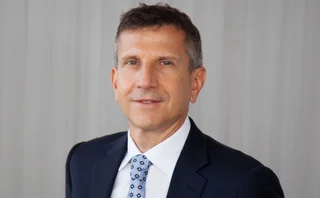
Trading concerns
The convictions of Ken Lay and Jeffrey Skilling in May closed a sorry chapter in energy trading. But it should be noted that much of what was good about Enron remains. However, some are concerned that Enron-like innovation now risks being stifled by lack of understanding, finds Stella Farrington
The convictions of Enron chiefs Ken Lay and Jeff Skilling marked the end of a difficult and unpleasant time in energy trading. Five years after the collapse of Enron and the catastrophic ripple it sent through energy markets, US power and gas markets are now booming again.
The temptation from here could be to consign Enron, and all its complex and less understood trading practices to a file labelled "bad, must not be allowed again." This, some market participants believe, is a very real danger. Some fear that the regulatory environment since Enron's collapse risks stifling market innovation going forward.
"An overly simplistic, and incorrect, lesson from the collapse of Enron is the simple assertion that energy trading is 'bad'," says John D'Agostino, founding partner of energy hedge fund MotherRock. "Enron's downfall was caused largely by fraud and arrogance, not something inherent in energy trading."
Disentangling the Enron fraud case from its trading practices is a very important exercise. However, it's one that's made difficult by the fact that Enron's trading business was struck down at a very young age, so it's not easy to tell whether its particular brand of asset light, physical trading was sustainable in every area it operated.
"The concept that one can achieve the same asset/liability exposures without having ownership of the physical asset or the liability is a logical one," says Shannon Burchett, chief executive of US-based risk consultancy Risk Limited. "It really gets to the heart of the physical versus financial debate. But there wasn't really enough time to see whether it worked or not."
Still at heart of energy markets
What is clearer is that many of Enron's innovative trading and risk management practices are still in operation at the heart of energy markets today. "The risk management experts at Enron really advanced the science of risk management and the tools it used to price some of these complex derivatives are still being used today," Burchett notes. Much of Enron's risk management practices now thrive in the investment banks who stepped in to fill the void after Enron, and who also hired some of the Enron diaspora.
And a more recent phenomenon has been the emergence of a few, highly sophisticated private entities adopting and adapting the merchant energy model to suit their trading businesses. Hedge funds such as Citadel, Saracen and Ritchie Energy are quite open about the fact that they are cherry-picking the best parts of the energy merchant banking model.
Proponents of the entry of hedge funds and other speculators in the energy markets argue that the environment is a very different one today to the one that Enron dominated. In its heyday, Enron was the counterparty on the other side of every trade it carried out. As it warehoused all its clients' risk, it had nowhere to offload its own risk. This was also why the effects of its collapse were felt so widely.
But the post-Enron market looks very different, largely thanks to the growth of clearing. Nymex ClearPort, and clearing on the IntercontinentalExchange in the US has meant the universe of energy trading has grown significantly. Not only does clearing eliminate third party credit risk, it also brings more players to the market, which further spreads risk around.
Risk is now spread across many specialised hedge funds, banks' proprietary desks, macro-funds, producers, consumers, and other market participants, rather than a single intermediary.
However, the role that speculators play in the market and the extent to which they should be allowed to operate is one that's fiercely debated and extends beyond concerns over the merchant energy model.
The US Commodity Futures Trading Commission (CFTC) wants to increase its authority to cover not just exchange-traded markets, but some over-the-counter (OTC) markets currently exempt from CFTC authority. These OTC markets are primarily populated by highly sophisticated commercial entities and some fear that regulators won't understand some of their more complex trading strategies.
As part of the US CFTC's pending reauthorisation bill, many in Congress have introduced legislation to increase its authority to cover not just exchange-traded markets, but some OTC markets currently exempt from CFTC authority.
CFTC Commissioner Sharon Brown-Hruska has concerns about the legislation. "In my opinion the level of regulation is appropriately different for exchange-traded markets and OTC market places," she says.
"One concern I've always had about applying exchange-style regulation to OTC markets is that it will cause people to move to still more opaque markets or offshore markets. This will have a negative effect on liquidity in the existing markets," says Brown-Hruska.
Increased range of regulation
The US Securities and Exchange Commission (SEC) has already increased the range of its regulation, with new rules effective February 2006 requiring hedge funds of a certain size to register with the SEC. A hedge fund advisor with more than 14 investors over the previous 12 months and at least $30 million in assets under management is now required to register as an investment advisor with the SEC. Offshore advisers are required by the new rules to count investors that are US residents, whether or not their funds are located offshore.
Registration with the SEC as an investment adviser entails amongst many things certain disclosure requirements, additional reporting and audit requirements if the advisor has custody of its client's assets, and periodic inspections by the SEC.
Brown-Hruska opposed the registration requirement, and now fears that it could stifle innovative trading practices. "It's a duplicative requirement for a start as these funds are already registered with the CFTC." But she also fears the concept of highly sophisticated traders having to reveal trading strategies to the SEC.
"If your company has a very sophisticated and innovative trading strategy, and the regulator is used to dealing with vanilla trades, the fear is that they will be inclined to discourage such trading," says Brown-Hruska. "This could discourage innovative trading and limit liquidity."
MotherRock's John D'Agostino shares the concern. "We have to be careful not to discriminate broadly against certain types of market participants, as that decreases transparency and makes markets less efficient. A market requires depth and breadth of participants, including speculators, to function effectively. Politics and emotion can harm the market by dissuading seasoned veterans from participating in the market in a speculative capacity. You want that talent in there to facilitate price discovery."
But, of course, for many people calamitous events such as the Metallgesellschaft oil derivatives scandal in the early 1990s and the Sumitomo copper crisis in the mid-1990s, still hold painful memories, and serve as a warning that you never know what's around the corner. Veteran economist Philip Verleger of US-based consultancy PK Verleger says: "I've been around this race track enough times to know that there is always going to be something else out there."
"Someone will eventually have a losing position which they double up on, or a bright idea that turns out not to be so good. I have learned that one should never say never," continues Verleger.
However, it is worth noting how much has changed since, and as a result of, past crises.
Shifts in reporting of risk profiles
As well as legislation such as Sarbanes Oxley, and the growth of clearing in recent months, there have been significant advances in risk management systems and in the dissemination of information about a company's risk profile to management.
In the case of Metallgesellschaft, its $1.5 billion derivatives losses occurred due to management's failure to understand the nature and level of risk exposure. Having decided to sell long-dated fuel and oil supply commitments to its end users, the company had used a 'stack and roll' futures programme to hedge its market risk.
Some time later, liquidity problems alarmed the supervisory board which instructed unwinding the futures position. "Hindsight shows us that the management were not seeing a delta matched physical/financial book and some curve and liquidity risk," says Thurstan Bannister, CEO of risk management software provider Sakonnet. "More timely and accessible risk reports might have illuminated the nature of their risk far earlier," he notes.
The Sumitomo crisis, in which head copper trader Yasuo Hamanaka disguised losses totalling $1.8 billion over a ten year period, might also have been avoided if the back office of Sumitomo had an aggregate real time view of all positions. "Hamanaka was able to hide his activities because he headed his section and had trade confirmations sent directly to himself, neatly by-passing the back office," says Bannister.
"However, an application that included real-time capture of all trades within the system and required independent back office verification before processing, might well have prevented this."
Developments in credit risk management software and advances in integrating physical and financial positions in real time also help to make today's environment safer.
But explaining these developments, as well as very sophisticated trading strategies to regulators is never going to be easy.Greater communication between regulators and market participants is essential, stresses William Hederman, executive director of Washington-based law firm Morgan Lewis Energy Resources Group, and former director of the Office of Market Oversight and Investigations at the Federal Energy Regulatory Commission.
"When market participants have concerns over regulation they need to approach the regulators more," he says. "Regulators take their responsibilities seriously but they don't know everything - it's the participants' responsibility to explain things."
Only users who have a paid subscription or are part of a corporate subscription are able to print or copy content.
To access these options, along with all other subscription benefits, please contact info@risk.net or view our subscription options here: http://subscriptions.risk.net/subscribe
You are currently unable to print this content. Please contact info@risk.net to find out more.
You are currently unable to copy this content. Please contact info@risk.net to find out more.
Copyright Infopro Digital Limited. All rights reserved.
As outlined in our terms and conditions, https://www.infopro-digital.com/terms-and-conditions/subscriptions/ (point 2.4), printing is limited to a single copy.
If you would like to purchase additional rights please email info@risk.net
Copyright Infopro Digital Limited. All rights reserved.
You may share this content using our article tools. As outlined in our terms and conditions, https://www.infopro-digital.com/terms-and-conditions/subscriptions/ (clause 2.4), an Authorised User may only make one copy of the materials for their own personal use. You must also comply with the restrictions in clause 2.5.
If you would like to purchase additional rights please email info@risk.net
More on Awards
Environmental products house of the year: ENGIE
ENGIE is driving change in energy transition, with a strong focus on renewable energy and the liberalisation of power markets in Apac, which presents significant long-term growth opportunities. In recognition of its efforts, ENGIE GEMS has been named…
Natural gas/LNG house of the year: ENGIE
ENGIE continues to expand its services to better serve firms in Apac dealing with the challenges of energy risk management and supply
FRTB management solution of the year: Bloomberg
Amid the diverging timeframes and complex requirements of FRTB, Bloomberg offers a consistent, comprehensive and customisable solution for Apac banks preparing for implementation
Newcomer of the year: Topaz Technology
Jon Fox and former colleagues formed Topaz Technology in 2015. Having seen many different systems and, in some cases, written and built a few themselves, there was always something missing, leading them to build a system that unifies risk reporting and…
Technology vendor of the year: Murex
As a technology vendor, Murex places adaptability front and centre of everything it does, constantly enriching its MX.3 platform to ensure institutions can respond to new market opportunities as soon as they spot them
Currency derivatives house of the year: Deutsche Bank
Asia Risk Awards 2024
Interest rate derivatives house of the year: Standard Chartered Bank
Asia Risk Awards 2024
Derivatives house of the year, Taiwan: CTBC Bank
Asia Risk Awards 2024







